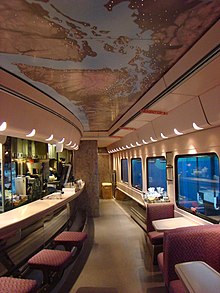Amtrak Cascades
| Amtrak Cascades (with distances in kilometers) |
|||||||||||||||||||||||||||||||||||||||||||||||||||||||||||||||||||||||||||||||||
|---|---|---|---|---|---|---|---|---|---|---|---|---|---|---|---|---|---|---|---|---|---|---|---|---|---|---|---|---|---|---|---|---|---|---|---|---|---|---|---|---|---|---|---|---|---|---|---|---|---|---|---|---|---|---|---|---|---|---|---|---|---|---|---|---|---|---|---|---|---|---|---|---|---|---|---|---|---|---|---|---|---|
|
|||||||||||||||||||||||||||||||||||||||||||||||||||||||||||||||||||||||||||||||||

Amtrak Cascades is a railway line of passenger traffic, which by Amtrak operates and in the northwest of the United States , the US states Oregon and Washington with the Canadian province of British Columbia joins. The connection is named after the cascade chain.
The route from Vancouver via Seattle and Portland to Eugene is 752 kilometers (467 miles) long and is traveled twice a day in each direction, in the middle section between Seattle and Portland even four times a day. Cascades ranks eighth among Amtrak-operated routes in terms of traffic.
An additional train on the Seattle-Portland-Eugene route runs daily as Coast Starlight to Los Angeles and back.
vehicles
Tilting trains from the Spanish manufacturer Talgo are used with a top speed of 200 km / h. For safety reasons, however, a maximum of 127 km / h is driven. Four of the five trains are named after mountains in the Cascades: Mount Rainier , Mount Baker , Mount Adams, and Mount Hood . The fifth was named after Mount Olympus in the Olympic Mountains .
Accidents
On December 18, 2017, Amtrak train 501 derailed in the railway accident at DuPont, southwest of Tacoma, except for the second locomotive following it, with a wagon falling off a bridge onto Interstate 5 . There were three dead and more than 100 injured. A speed that was clearly too high was named as the cause of the accident.
See also
Web links
- Amtrak Cascades (official site)

